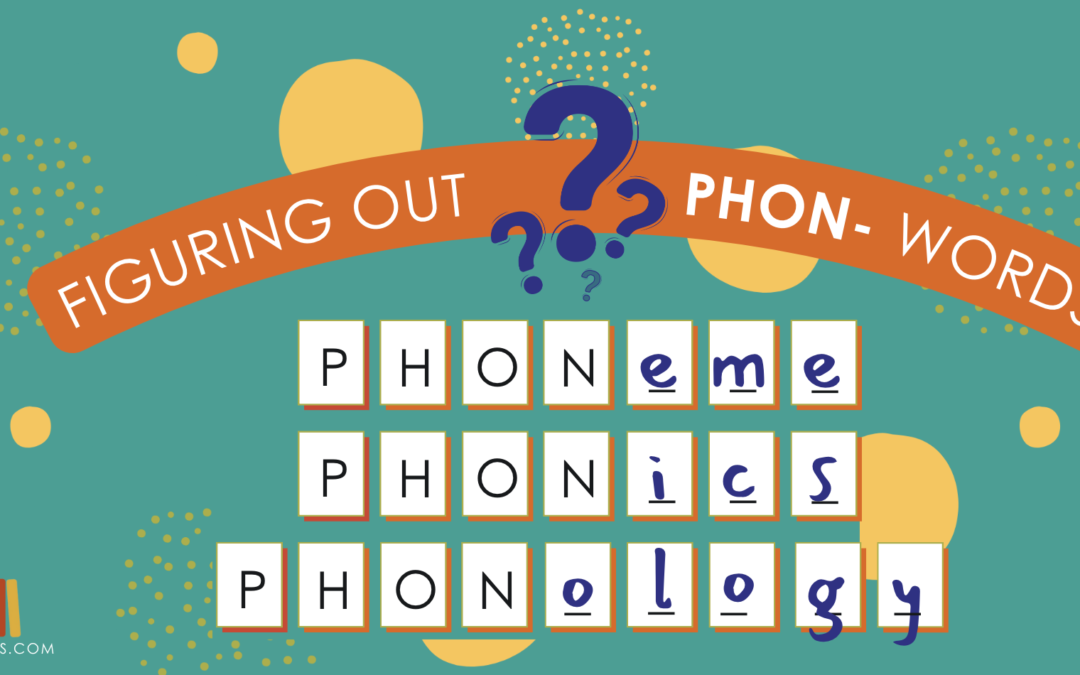Despite the recent shift to providing students with more science-aligned foundational skills instruction, we find that a pesky confusion about the phon- words, phonemic awareness vs. phonics, persists. This confusion arises not only because these words sound similar but also because there is a great deal of overlap between the concepts they represent.
So, what are the important differences between phonemic awareness and phonics? And how can we keep these ph- words straight?
Today, we offer some clarification on these /ph/ terms as well as some important DOs and one DON’Ts for more brain-friendly foundational skills instruction.
Defining the Difference in Phonemic Awareness vs. Phonics
What is PHONEMIC AWARENESS?
Phonemic awareness is the ability to hear, distinguish, and manipulate the smallest individual sounds in spoken words, which are called phonemes.
Phonemes, although the smallest units of sound in a spoken language, play the enormous role of making it possible to distinguish one word from another. For example, in English, the words “bat” and “cat” differ by only one phoneme: the initial sounds /b/ and /k/.
Only by becoming aware of individual phonemes (phonemic awareness) will children be able to understand the positionality and relationships of the individual spoken sounds within a word, which is critical to remembering words and reading fluently. In fact, phonemic awareness is critical for many different things when it comes to reading—alphabetic principle, decoding, spelling, and even orthographic mapping.
What are some examples of PHONEMIC AWARENESS skill practice?
- Phoneme Isolation: Identifying individual sounds in words.
- “What is the first sound in the word ‘cat’?” (/k/).
- “What is the last sound in the word ‘sit’?” (/t/).
- Phoneme Blending: Listening to a sequence of separately spoken sounds and combining them to form a word.
- “What word do these sounds make: /s/ /a/ /t/?” (sat).
- Phoneme Segmentation: Breaking a word into its individual sounds.
- “How many sounds are in the word ‘ship’?” (/sh/ /i/ /p/—3 sounds).
- “Say the word ‘dog’ one sound at a time.” ( /d/ /o/ /g/).
- Phoneme Deletion: Recognizing what remains when a phoneme is removed from a word.
- “What is ‘smile’ without the /s/?” (mile).
- “Say ‘cart’ without the /k/.” (art).
- Phoneme Addition: Making a new word by adding a phoneme to an existing word.
- “What word do you get if you add /s/ to the beginning of ‘top’?” (stop).
- Phoneme Substitution: Changing one phoneme in a word to make a new word.
- “Change the /sh/ in ‘shop’ to /m/. What’s the new word?” (mop).
- “Change the /g/ in ‘tug’ to /b/. What’s the new word?” (tub).
It’s important to understand that phonemic awareness is a subset of the more general term, phonological awareness. Phonological awareness is an umbrella term referring to the work with various sized sound structures. It includes bigger chunks of language—sentences, words, syllables, rimes, etc.—but it also includes those individual sounds known as phonemes.
Think of it like this. All poodles are dogs, but not all dogs are poodles. In the same way, all phonemic awareness work is a type of phonological awareness, but not all phonological awareness tasks are phoneme-level tasks.
And when it comes to phonological tasks, phonemic awareness is the star!
Then, what is PHONICS?
Phonics is the alphabetic code that enables the brain to translate written language back into spoken language and comprehend the ideas the code represents.
Phonics instruction involves emphasizing the relationship between written symbols (graphemes) and the sounds they represent (phonemes). During phonics instruction, children learn the rules of the road for decoding (reading) and encoding (writing) the spoken language, beginning with the simplest, most predictable sound-spellings and moving to more complex ones.
What are examples of PHONICS skill practice?
- Letter Naming: Identifying individual letters (rapidly)
- “I’ll point to a letter, and you tell me what it is.” (K).
- “See if you can name all the letters that spell your partner’s name.”
- Letter Formation: Writing letters by hand and in efficient ways
- “Here is how you write the letter P. Start at the top, go straight down, go back up, and make a loop.” (Model each step as it is described.)
- “I’m going to call out the names of some letters, and you write each one on your board. Write the letter M.”
- Spelling Sounds with Letters and Letter Combinations: Making the connection between the individual sounds and the letter(s) that spell them.
- “Today, we’re going to learn how to spell the sound /mmm/, which is the sound you hear at the beginning of the word moon..”
- “The sound /b/ is spelled with the letter B.”
- “The letter K is one way to spell the sound /ck/.”
- Encoding: Stretching out a spoken word and writing (in order) the graphemes that represent each sound. In other words, translating spoken language into written language.
- “Stretch out the word and write the spelling for each sound in order.”
- “Write the word by spelling each sound one at a time. Reread the sounds you have so far every time you add another one.” (f, fi, fish).
- Decoding: Translating individual graphemes into their sounds and blending those together to read a word. In other words, translating written language into spoken language.
- “Sound it out.”
- “Say each sound in the word without stopping in between them like this /rrruuunnn/.”
- “Blend each sound together until you can hear the word.”

What are the most important elements of effective PHONEMIC AWARENESS vs. PHONICS Instruction?
- They are BOTH systematic, which means they are built around a gradual and thoughtful plan (scope and sequence) for instruction.
- The plan builds from simple to more complex.
- A common scope and sequence is shared by all staff across a building.
- They are BOTH explicit, with clear and direct explanations and opportunities for practice and feedback.
- The teacher consistently uses a flexible set of brain-friendly learning routines.
- Instruction is provided in large-group and small-group settings.
- They are BOTH cumulative, with a plan for review and assessment of previously taught skills.
- There are frequent opportunities for practice and feedback
- Word lists and decodable texts include strategic opportunities for cumulative review.
- Weekly spelling dictation (formative assessment) includes new and review skills.
What are some DOs and DON’Ts of PHONEMIC AWARENESS vs PHONICS?
1. Prioritizing

DON’T LINGER on the more general phonological awareness tasks (rhyming, alliteration, syllable level work), and don’t teach phonics through word families and rhyme. These broader skills aren’t “prerequisites” for the more specific phoneme-level work. Although more general phonological tasks can be really fun for children, and children will eventually recognize the rime in written words, reading is about the phoneme-level work!

DO PRIORITIZE instructional work at the phoneme level (phonemic awareness) beginning as early as Pre-K because it has more critical and direct implications for learning to read and write. The good news is that as children become readers, some of these broader phonological skills (i.e., rhyming) often become easier to master with the support of print.

DON’T NEGLECT intentional instruction in both phonemic awareness and phonics. Students don’t have to struggle before you offer extra support. Rather, begin Tier 1 phonemic awareness instruction in Pre-K and continue through the early grades. And don’t forget to employ simple formative assessments so you can provide additional review and practice for students who need it, especially with those “power skills” of blending and segmenting.

DO FORTIFY your understanding of effective phonemic awareness and phonics instruction, including what makes a task more or less difficult, such as the type of sounds (i.e., stop vs. continuant), word length, and the position of the phoneme in a word. This will inform your intentional instruction and make phonemic awareness and phonics instruction more brain-friendly for students. Shift 2 of the K-2 Shifting the Balance book and online class are dedicated to helping you do this very thing.

DON’T HYPER FOCUS on phonics and phonemic awareness instruction word work in isolation. Make sure your lessons include opportunities for reading and writing words in context as well. This might mean working with sentences, short passages, or decodable texts. And don’t forget to engage students with the meanings of their practice words. If not, kids will begin to disconnect decoding and meaning-making and can even habituate ignoring the meaning as they decode.

DO INTEGRATE phonemic awareness work into your phonics instruction and vice-versa! Phonics knowledge supports phonemic awareness development, and phonemic awareness instruction can support the success of phonics. So bring letters into your phonemic awareness instruction, and work segmenting and blending into your phonics instruction. You can start this win-win connection as soon as students have just a few sound spellings under their belts. Elkonin boxes (sound boxes) and word chains are great tools for supporting the reciprocal relationship between phonics and phonemic awareness.

DON’T SKIMP on writing! These foundational skills are most easily learned (and assessed) when students have the opportunity to apply them through writing. Writing involves listening to the sounds in a word in sequential order as students write the sound spelling for each one, which is a beautiful integration of phonics and phonemic awareness. In fact, writing the sound-spellings while saying the sounds anchors both in memory.

DO KEEP THE TOOLS and resources to support and extend phonics and phonemic awareness instruction close at hand. For example, select and display consistent sound-spelling keywords, and equip yourself with word lists and decodable texts to support each of the skills you’ll be teaching.
Key Takeaways for Teaching Phonemic Awareness vs. Phonics (or is it Phonics vs. Phonemic Awareness? 😉)
As you can see, because the focus of both phonemic awareness and phonics is the individual sounds within words, the line between the two is understandably blurry.
As you work to make learning to read easier rather than harder for children, understanding how these two phon-terms differ and overlap is an essential building block in your foundational skills instruction.
So, let’s sum up! Here are a few key takeaways from this post:
Phonemic awareness is a subset of the broader set of skills referred to as phonological awareness.
All phonemic awareness work is a kind of phonological awareness, but not all phonological awareness tasks are phoneme-level tasks.
Phoneme-level work (phonemic awareness instruction) has the most direct impact on reading and writing success, so we should start with children early.
The other phonological tasks (rhyming, alliteration, syllable clapping) are not prerequisites to phoneme-level work (or reading).
Successful phonics instruction depends on the development of phonemic awareness since it focuses on teaching children the relationship between the individual sounds in spoken words and the spellings that represent them in written language.
Don’t limit phonemic awareness instruction to oral practice. Research shows that bringing phonemic awareness and phonics instruction together as soon as children have learned a few sound-spellings is most beneficial.
If you want to learn more about high-leverage phonemic awareness and phonics instruction, we encourage you to check out our Shifting the Balance books and online classes, where we offer more examples and give these two critical topics even more love.
-

Jan Burkins and Kari Yates are authors, speakers, and consultants, who are dedicated to helping teachers around the world translate reading science into simple instructional moves that help teachers make learning to read easier for their students while still centering meaning-making, engagement, and joy.
Recent Posts



I love this. Thank you so much for that clear explanation. I’ll be sharing this with my teacher candidates.